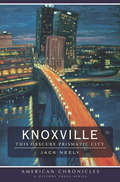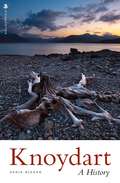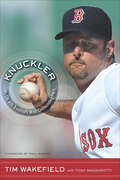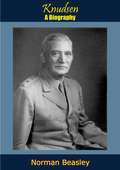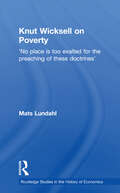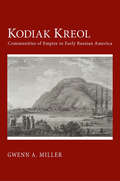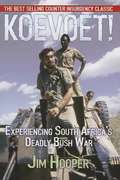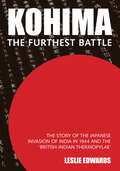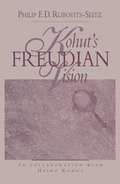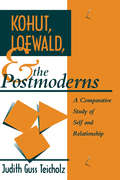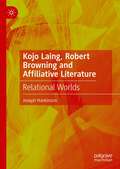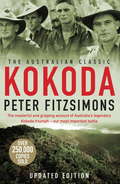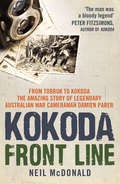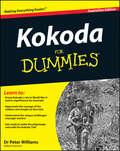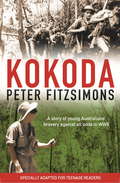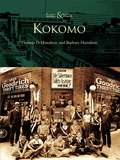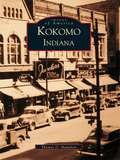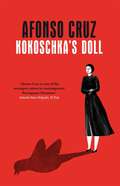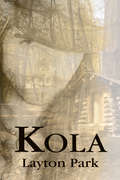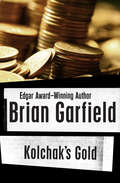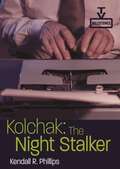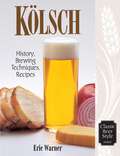- Table View
- List View
Knoxville: This Obscure Prismatic City
by Jack NeelyDiscover the vibrant history of Knoxville, Tennessee, in this series of articles from Jack Neely's acclaimed "Secret History" column in Knoxville's Metro Pulse. Neely delves into the shadows of centuries past and weaves a path of local history with unmistakable wit and precision. Learn about the people who made Knoxville the "obscure prismatic city" through their genius, bravery or even impiety--natives like Adolph Ochs, whose fear of the old Presbyterian cemetery kick-started his ascent to the editor's desk at the New York Times; Clarence Brown, the University of Tennessee graduate turned Hollywood icon; and Knoxville's own Mark Twain. Learn about race riots, labor riots and good old-fashioned drunken riots, and discover why Knoxville is Tennessee's forgotten music city.
Knoydart: A History
by Denis RixsonA local historian chronicles the famously remote region of the Scottish Highlands from its early Viking settlers to the present day. Located in the &“Rough Bounds&” of northern Scotland, the remote region of Knoydart is Britain&’s last true wilderness. Deriving its name from Viking settlers, the desolate peninsula was home to warlike inhabitants who became notorious in the 18th century under the ruthless leadership of Coll of Barrisdale. Notorious across Scotland, his protection racket gave the word &“blackmail&” to the English language. Knoydart was also a fertile recruiting ground for the Jacobites. But in the 18th and 19th centuries the area suffered large scale emigration, partly as a result of the brutal clearances of 1853. A long century of decline followed until, in 1948, it became the scene of the famous land-raid by the &“Seven men of Knoydart.&” Today, Knoydart continues to be the focus of land settlement and reform controversies. Local historian Denis Rixson places these issues in their larger historical context. It is the story of a community&’s ongoing struggle to preserve itself against the harshness of the environment and the cynical exploitation of man.
Knuckler: My Life with Baseball's Most Confounding Pitch
by Tony Massarotti Tim WakefieldAt forty-four years old, Tim Wakefield is the longest-serving member of one of baseball’s most popular franchises. He is close to eclipsing the winning records of two of the greatest pitchers to have played the game, yet few realize the full measure of his success. That his career can be characterized by such words as dependability and consistency defies all odds because he has achieved this with baseball’s most mercurial weapon—the knuckleball. Knuckler is the story of how a struggling position player bet his future on a fickle pitch that would define his career. The pitch may drive hitters crazy, but how does the pitcher stay sane? The moment Wakefield adopted the knuckleball, his career sought to answer that question. With the Red Sox, Wakefield began to master his pitch only to find himself on the mound in 2003 for one of the worst post-season losses in history, followed the next year by one of the most vindicating of championships. Even now, as Wakefield battles, we see the twists and turns of a major league career pushed to its ultimate extreme. A remarkable story of one player’s success despite being the exception to every rule, Knuckler is also a lively meditation on the dancing pitch, its history, its mystique, and all the ironies it brings to bear.
Knudsen: A Biography
by Col. Norman BeasleyKnudsen tells the tale of the immigrant bicycle mechanic who revolutionized American industry and buried the Axis powers with mass production. Norman Beasley presents the story of Signius Wilhelm Poul Knudsen, a young man who came to the U.S. with an unshakeable faith in American opportunity, an eye for efficiency, and twenty dollars in his pocket. Four decades later, that man would become Lieutenant-General William S. Knudsen, the mind behind America’s production at the most crucial point in modern history.Knudsen began his time in American industry in the shipyards and factories, eventually landing a job as foreman in a bicycle manufacturing plant. He quickly demonstrated his skill in organizing production. Henry Ford took notice and bought the company on the condition that Knudsen come work for him. Knudsen succeeded everywhere he went, leading first Ford and later Chevrolet to dominating the automobile markets.When WWII loomed on the horizon, President Roosevelt needed the best production man in the country to give the U.S. and its allies a fighting chance; he chose Knudsen.This inspiring story shows a man who believed in and achieved the American dream, rising from rags to riches and changing not only the world of his time, but the course of history. Without Knudsen, America, and indeed the world, might have faced a much darker future.
Knut Wicksell on the Causes of Poverty and its Remedy (Routledge Studies in the History of Economics #Vol. 73)
by Mats LundahlKnut Wicksell is arguably the greatest Swedish social scientist of all time, and poverty was a theme that occupied him all his life. Indeed, it was probably Wicksell's interest in poverty that was the critical factor in drawing him away from his purely mathematical background towards a greater understanding of the social sciences as a whole. In this outstanding volume, Mats Lundahl, one of the world's leading development economists, examines Wicksell's thinking in the area of poverty, and shows the importance of his contributions to this field.
Ko-Uta: Little Songs of the Geisha World
by Liza CrihfieldThis book of Japanese poetry and lyrics explores a little-known style of Japanese song called Ko-Uta.A Ko-Uta is translated as "little song" in Japanese. Unfamiliar to most Westerners, ko-uta are particularly in tune with the tradition of Japan's Edo-era merchants. Some ko-uta are aesthetic, many are earthy.Ko-uta are sung to the accompaniment of the shamisen-a traditional, three-stringed Japanese lute. Ko-uta come to life when they are sung, and the best example of where they live is in the geisha world. To help give some idea of the geisha world, this Japanese music book has provided a complete score of one song.Readers with some experience with haiku and other forms of Japanese poetry will find that ko-uta share many things with those forms. Yet, ko-uta retain their own unique interest, making this book a fascinating addition to any collection of Japanese literature or art.
Kochland: The Secret History Of Koch Industries And Corporate Power In America
by Christopher Leonard‘A landmark book....A massively reported deep dive into the unparalleled corporate industrial giant Koch Industries....This impressively researched and well-rendered book also serves as a biography of Charles Koch, with Leonard providing an evenhanded treatment of the tycoon. Leonard's work is on par with Steve Coll's Private Empire and even Ida Tarbell's enduring classic The History of the Standard Oil Company.’ Kirkus Reviews ‘Leonard’s superb investigations and even-handed, clear-eyed reportage stand out....American capitalism at its most successful and domineering is at the center of this sweeping history of a much-vilified company.’ Publishers Weekly ‘Leonard’s intricately developed and extensively researched history of the Koch empire is a colossal corporate biography that sheds important light on this closely guarded enterprise while simultaneously scrutinizing the nefarious underpinnings of American economic policies and practices.’ Booklist ‘This page-turning exposé reveals the full extent of the Koch brothers’ influence on American capitalism.’ Book Riot ‘If you want a crash course in the evolution of postmodern capitalism over the last five decades read Kochland....Leonard's study is exhaustive and engaging.’ New York Journal of Books The annual revenue of Koch Industries is bigger than that of Google, Goldman Sachs and Kraft Foods combined. But very few people have ever heard of Koch Industries because the billionaire Koch brothers want it that way. Now, in Kochland, Christopher Leonard has managed what no other journalist has done before: to tell the explosive inside story of how the largest private company in the world became that big. In doing so, Leonard also tells the epic tale of the evolution of corporate America over the last half-century, in all its glory and rapaciousness. Koch is everywhere. It controls the fertilisers at the foundation of our food system. It controls the synthetics that make our diapers and carpets. It controls the chemicals that make our bottles and pipes. It controls the building materials that make our homes and offices. And it controls much of the Wall Street trading in all of these commodities. It makes money at every end of almost every deal. For five decades, CEO Charles Koch has kept Koch Industries quietly operating behind a veil of secrecy, with a view toward very, very long-term profits. When Wall Street came calling twenty years ago, trying to take Koch public, Charles Koch said no. He’s a genius businessman: patient with profits, able to learn from his mistakes, determined that his employees develop an almost a worshipful dedication to free-market ruthlessness, and a master disrupter. We think of disruption as something that happens in Silicon Valley, but this book will upend your understanding of what disruption really is. Charles Koch’s business acumen has made him and his brother David (Koch Industries’ co-owner) together richer than Bill Gates. But there’s a dark side to their story. If you want to understand how we killed the unions in this country, how we widened the income divide, how we stalled progress on climate change and how corporate America bought the influence industry, all you have to do is read this book. Seven years in the making, Kochland reads like a true-life thriller, with larger-than-life characters driving the battles on every page. The book tells the ambitious tale of how one private company consolidated power over half a century – and how in doing so, transformed capitalism into something that feels so deeply alienating to many Americans today.
Kochland: The Secret History of Koch Industries and Corporate Power in America
by Christopher LeonardNEW YORK TIMES BESTSELLER * NEW YORK TIMES NOTABLE BOOK OF 2019 * WINNER OF THE J ANTHONY LUKAS WORK-IN-PROGRESS AWARD * FINANCIAL TIMES&’ BEST BOOKS OF 2019 * NPR FAVORITE BOOKS OF 2019 * FINALIST FOR THE FINACIAL TIMES/MCKINSEY BUSINESS BOOK OF 2019 * KIRKUS REVIEWS BEST BOOKS OF 2019 * SCHOOL LIBRARY JOURNAL BEST BOOKS OF 2019 &“Superb…Among the best books ever written about an American corporation.&” —Bryan Burrough, The New York Times Book Review Just as Steve Coll told the story of globalization through ExxonMobil and Andrew Ross Sorkin told the story of Wall Street excess through Too Big to Fail, Christopher Leonard&’s Kochland uses the extraordinary account of how one of the biggest private companies in the world grew to be that big to tell the story of modern corporate America.The annual revenue of Koch Industries is bigger than that of Goldman Sachs, Facebook, and US Steel combined. Koch is everywhere: from the fertilizers that make our food to the chemicals that make our pipes to the synthetics that make our carpets and diapers to the Wall Street trading in all these commodities. But few people know much about Koch Industries and that&’s because the billionaire Koch brothers have wanted it that way. For five decades, CEO Charles Koch has kept Koch Industries quietly operating in deepest secrecy, with a view toward very, very long-term profits. He&’s a genius businessman: patient with earnings, able to learn from his mistakes, determined that his employees develop a reverence for free-market ruthlessness, and a master disrupter. These strategies made him and his brother David together richer than Bill Gates. But there&’s another side to this story. If you want to understand how we killed the unions in this country, how we widened the income divide, stalled progress on climate change, and how our corporations bought the influence industry, all you have to do is read this book. Seven years in the making, Kochland &“is a dazzling feat of investigative reporting and epic narrative writing, a tour de force that takes the reader deep inside the rise of a vastly powerful family corporation that has come to influence American workers, markets, elections, and the very ideas debated in our public square. Leonard&’s work is fair and meticulous, even as it reveals the Kochs as industrial Citizens Kane of our time&” (Steve Coll, Pulitzer Prize–winning author of Private Empire).
Kodiak Kreol: Communities of Empire in Early Russian America
by Gwenn A. MillerFrom the 1780s to the 1820s, Kodiak Island, the first capital of Imperial Russia's only overseas colony, was inhabited by indigenous Alutiiq people and colonized by Russians. Together, they established an ethnically mixed "kreol" community. Against the backdrop of the fur trade, the missionary work of the Russian Orthodox Church, and competition among Pacific colonial powers, Gwenn A. Miller brings to light the social, political, and economic patterns of life in the settlement, making clear that Russia's modest colonial effort off the Alaskan coast fully depended on the assistance of Alutiiq people. In this context, Miller argues, the relationships that developed between Alutiiq women and Russian men were critical keys to the initial success of Russia's North Pacific venture. Although Russia's Alaskan enterprise began some two centuries after other European powers--Spain, England, Holland, and France--started to colonize North America, many aspects of the contacts between Russians and Alutiiq people mirror earlier colonial episodes: adaptation to alien environments, the "discovery" and exploitation of natural resources, complicated relations between indigenous peoples and colonizing Europeans, attempts by an imperial state to moderate those relations, and a web of Christianizing practices. Russia's Pacific colony, however, was founded on the cusp of modernity at the intersection of earlier New World forms of colonization and the bureaucratic age of high empire. Miller's attention to the coexisting intimacy and violence of human connections on Kodiak offers new insights into the nature of colonialism in a little-known American outpost of European imperial power.
Koevoet: Experiencing South Africa's Deadly Bush War
by Jim Hooper<p>Koevoet! has been an global bestseller since its release over 20 years ago. This new edition goes far beyond the original in capturing the courage, fear and intensity of South Africa's deadly bush war. Never before had an outsider been given unrestricted access to Koevoet, the elite South West African Police counterinsurgency unit - also known as Operation K and officially as the South West Africa Police Counter Insurgency Unit (SWAPOL-COIN). Author Jim Hooper spent a total of five months embedded with the semi-secret and predominantly black 'Ops K', which climaxed with one of the most vicious and determined infiltrations ever mounted by the communist-backed South West Africa People s Organization (SWAPO). Crossing regularly into Angola in pursuit of the insurgents, he saw friends die next to him and was twice wounded himself. <p>This updated edition, drawing on the recollections and diaries of the men he rode with, will fascinate yet another generation of readers. In assembling this work, Jim Hooper had the opportunity to re-connect with so many of the men who allowed this outsider to ride with them. All of which brought a new intensity and poignancy. It also reminded Jim Hooper how privileged he was to have been witness to Koevoet's war. This stunning work is a tribute to Koevoet and the legend they created.</p>
Kohima: The Story of the Japanese invasion of India in 1944 and the 'British-Indian Thermopylae'
by Leslie EdwardsBy the end of 1943 the Japanese had occupied most of South-East Asia. On 6 March 1944, the first units of the Japanese 15 Army crossed the inhospitable border of what was then Burma, and invaded India. At the township of Kohima they were met by a small, hastily assembled force of Indian and British troops, later reinforced by 2 Division of Slim's 14 Army, who fought valiantly and forced the Japanese to retreat.Described by Mountbatten as 'the British/Indian Thermopylae', Kohima was a turning point in Japanese fortunes, heralding their continued defeat in battle until their formal surrender on 2 September 1945. Using extensive research in primary sources and many previously unpublished first-hand accounts, Leslie Edwards presents a definitive analysis of this pivotal battle.
Kohut's Freudian Vision
by Philip F. Rubovits-SeitzHeinz Kohut was arguably the most influential modern day psychoanalyst. Because current interest in Kohut's work has focused so completely on self psychology, however, certain aspects of Kohut's thinking, in particular his nonreductive synthesis of Freudian theory, are in danger of being lost. Prior to his development of self psychology, Kohut was a legendary teacher of Freudian theory at the Chicago Institute for Psychoanalysis. In this volume, Philip Rubovits-Seitz presents Kohut's previously unavailable lectures from his course on psychoanalytic psychology (prepared in collaboration with Kohut himself) along with an illuminating summary statement on Freudian theory jointly written by Kohut and Rubovits-Seitz.Rubovits-Seitz continues with his own insightful analysis of Kohut's distinctive approach to Freudian theory. And he concludes by arguing persuasively why Kohut's later contributions should best be viewed as a continuation, rather than an abandonment, of this early vision. Kohut's Freudian Vision not only repairs an outstanding tear in received psychoanalytic history but also challenges self psychologists and contemporary Freudian psychoanalysts alike to renewed reflection.
Kohut, Loewald and the Postmoderns: A Comparative Study of Self and Relationship (Psychoanalytic Inquiry Book Series #No. 18)
by Judith G. TeicholzIn Kohut, Loewald, and the Postmoderns, Judith Teicholz, using the contemporary critique of Kohut and Loewald as a touchstone of inquiry into the current status of psychoanalysis, focuses on a select group of postmodern theorists whose recent writings comprise a questioning subtext to Kohut's and Loewald's ideas. Acutely aware of the important differences among these theorists, Teicholz nonetheless believes that their respective contributions, which present psychoanalysis as an interactive process in which the analyst's own subjectivity plays a constitutive role in the joint construction of meanings, achieve shared significance as a postmodern critique of Kohut and Loewald. She is especially concerned with the relationship - both theoretically and technically -between Kohut's emphasis on the analyst's empathic resonance with the analysand's viewpoint and affect, and the postmodern theorists' shared insistence on the expression of the analyst's own subjectivity in the treatment situation. Her analysis incorporates fine insight into the tensions and ambiguities in Kohut and Loewald, whose work ultimately emerges as a way station between modern and postmodern viewpoints, and her appreciation of Kohut and Loewald as transitional theorists makes for an admirably even-handed exposition. She emphasizes throughout the various ways in which Kohut and Loewald gave nascent expression to postmodern attitudes, but she is no less appreciative of the originality of postmodern theorists, who address genuine lacunae in the thought and writings of these exemplars of an earlier generation. Teicholz's examination of what she terms two overlapping "partial revolutions" in psychoanalysis - that of Kohut and Loewald on one hand and of the postmoderns on the other - throws an illuminating searchlight on the path psychoanalysis has traveled over the last quarter of the 20th century.
Kojo Laing, Robert Browning and Affiliative Literature: Relational Worlds
by Joseph HankinsonThis book compares the Victorian British poet Robert Browning and the twentieth-century Ghanaian poet and novelist Kojo Laing—two writers whose texts frequently foreground multi-scalar transregional cartographies, points of connection and translation, and imaginative kinships between different linguistic and cultural communities. Starting from the numerous and surprising points of connection and resemblance between both authors’ texts, this book puts pressure on critical practices that would keep writers like Laing and Browning separate, positing instead the importance of paying attention to the transnational, cross-cultural, and cross-temporal imaginative relationships texts themselves generate. By comparing two writers whose texts represent different points of view on a number of shared and congruent contexts, this book seeks an original way of understanding the relationship between texts and (post-) colonial contexts, texts and other texts. Browning’s and Laing’s shared tendency to foreground trans- and post-national cartographies of relation and difference, and their similarly translational aesthetics, both demand a probing of the disciplinary separation between ‘English Literature’ and ‘Comparative Literature’, as well as ‘literature’ and ‘comparison’, and a fresh awareness of the ways in which literature itself makes comparisons and affiliations. It also involves a version of ‘world literature’ intent on accentuating the relational worlds (linguistic, imaginative, ethical) that texts themselves generate; a criticism sensitive to the ways in which writers from different times and places can still be seen to overlap.
Kokoda
by Peter Fitzsimons`an engrossing narrative, beautifully controlled by a master storyteller' Michael McKernan, Sydney Morning Herald The bestselling, acclaimed, authoritative account of one of the most famous battles in Australian military history ? now established as a classic. For Australians, Kokoda is the iconic battle of World War II, yet few people know just what happened ? and just what our troops achieved. In his bestselling book, Peter FitzSimons tells the Kokoda story in his distinctive gripping style. Conditions on the track were hellish ? rain was constant, the terrain close to inhospitable, food and ammunition supplies were practically non-existent and the men constantly battled malaria and dysentery, as well as the Japanese. Kokoda was a defining battle for Australia ? a small force of young, ill-equipped Australians engaged a highly experienced and hitherto unstoppable Japanese force on a narrow, precarious jungle track ? and defeated them.
Kokoda Front Line
by Neil McDonaldDamien Parer was without doubt Australia?s greatest war photographer. He helped create the Anzac legend ? and many, many of our iconic war images are his photographs. He served his apprenticeship as a stills photographer on the famous Chauvel film, 'Forty Thousand Horsemen', and was appointed Official Photographer covering the Australian fighting in the early days of World War II in Greece and Syria, and Tobruk. His most famous documentary is 'Kokoda Front Line!' , made during the darkest days of the campaign in mid-1942 (it went on to win Australia?s first Academy Award). His photographs and films brought the war home to Australians ? and are now an integral part of our military history. He died in action ? shot by Japanese machine gun fire, as he filmed an American advance on Peleliu. Originally published as WAR CAMERAMAN: THE STORY OF DAMIEN PARER, and later in an expanded form as DAMIEN PARER'S WAR, this colourful and authoritative story of a great Australian includes many of his most iconic photographs.
Kokoda Trail for Dummies
by Peter WilliamsEverything you need to know about the Kokoda Trail and its place in Australian history Interest in the Kokoda Trail is growing rapidly among many Australians, both for its attraction as a hiking destination and for its historical significance. Kokoda For Dummies offers a fast track tool for learning everything you need to know about this unique thoroughfare, in one concise volume. Part history book, part practical guide, Kokoda For Dummies is perfect both for those considering following our Diggers’ footsteps along ‘the track’ or armchair travellers who want to learn about its history. Covering the full history of the Kokoda Trail, from its beginnings as an overland mail route to the fierce battles between the Australians and the Japanese that took place along its length during World War II, the book also includes important information on walking the trail yourself. From the steps you need to take to get ready to what to bring, Kokoda For Dummies is the definitive resource for anyone looking for a comprehensive overview of this significant landmark. Focuses on walking the track as a pilgrimage and a history lesson for history buffs and hiking enthusiasts alike Covers the health and safety concerns involved with walking the track, including a basic Kokoda itinerary Contains eyewitness accounts of the Kokoda battles gleaned from interviews conducted with Australian and Japanese war veterans A comprehensive but accessible history of the Kokoda Trail and its significance to Australia, in one volume.
Kokoda: Younger Readers
by Peter FitzsimonsA story of young Australians' mateship and bravery against all odds in WWIIFor Australians, Kokoda is the iconic battle of World War II, yet few people know just what happened - and just what our troops achieved. In this new edition of his bestselling account of this seminal battle, Peter FitzSimons tells the Kokoda story in a gripping, moving story specially geared for high-school age readers. Conditions on the track were hellish - rain was constant, the terrain close to inhospitable, food and ammunition supplies were practically non-existent and the men constantly battled malaria and dysentery, as well as the Japanese. Kokoda was a defining battle for Australia - a small force of young, ill-equipped Australians engaged a highly experienced and hitherto unstoppable Japanese force on a narrow, precarious jungle track - and defeated them.Prase for the original edition:'an engrossing narrative, beautifully controlled by a master storyteller' The Sydney Morning Herald
Kokomo
by Barbara Hamilton Thomas D. HamiltonAs we move out of the past and into the present, our landscape is forever altered by the passing of time. The face of Kokomo, "The City of Firsts," has changed over the years. Once an image of small-town Americana, Kokomo has grown-expanding its industrial reach, enticing new residents, and continuing to be the first in a number of fields.Kokomo, Indiana: Then and Now takes the reader back to a simpler time in Kokomo history. Using historic images paired with contemporary photos, authors Thomas D. and Barbara Hamilton have created a charming view of the area's history and evolution.
Kokomo, Indiana (Images of America)
by Thomas D. HamiltonAccording to legend, Kokomo, Indiana was named after a Miami Indian Chief who lived in the area, "Ma Ko Ko Mo" -meaning Black Walnut. Founded in 1842 by David Foster, a frontier trader, Kokomo has since become the home to many of the nation's most influential inventions. From the birthplace of the automobile to the introduction of stainless steel and the development of canned tomato juice, Kokomo has been a leader in ingenuity, earning its nickname, the "City of Firsts." In this collection of reminiscent images, Kokomo, Indiana illustrates the charming history of an area which has developed from a small community to what is now one of the largest cities in Indiana. The book is an exploration of the city's streets and a stroll through the history of its growing neighborhoods, tracing the fascinating past of a bygone age.
Kokoschka's Doll
by Afonso Cruz"A novel par excellence that is destined to become a classic' of almost byzantine splendour . . . At its best worthy of comparison with Gabriel García Márquez" Catherine Taylor, Irish Times"Afonso Cruz is one of the strongest voices in contemporary Portuguese literature" Antonio Saez Delgado, El PaisAt the age of forty-two, Bonifaz Vogel begins to hear a voice.But it doesn't belong to the mice or the woodworm, as he first imagines. Nor is it the voice of God, as he comes to believe. It belongs to young Isaac Dresner, who takes refuge in the cellar of Vogel's bird shop on the run from the soldier who shot his best friend. Soon Vogel comes to rely on it for advice: he cannot make a sale without first bending down to confer with the floorboards. Thus begins the story of two Dresden families, fractured and displaced by the devastating bombing of the city 1945, their fates not only intertwined, but bound also to that of a life-sized doll commissioned by the artist Oskar Kokoschka in the image of his lost lover.Based on a curious true story, Kokoschka's Doll is an imaginative and playful novel that transports the reader to Dresden, Paris, Lagos and Marrakesh, introducing them to an unforgettable cast of characters along the way.Translated from the Portuguese by Rahul Bery
Kola
by Layton ParkNorthern Soldiers killed Liam’s parents and left the half white, half Chinese boy for dead. The feared Quantrill’s raiders, rescued him to fight for the racially intolerant south. To hide his Chinese roots, he changed his name and posed as an Indian scout. After the war, all Quantrill’s men were to be rounded up and hung so he joined a horse drive to Canada. Someone among the Chinese miners murdered the tax collector pitting the Chinese against the white community. Kola is forced to decide which side he will support.
Kolchak's Gold
by Brian GarfieldOn the hunt for long-lost gold, a historian attracts murderous attentionTwenty-five million people died during the Russian Civil War. It was a clash between Tsarist loyalists and the new Soviet order, and when the imperialist forces saw defeat in sight, their thoughts turned to their future. Under the command of Admiral Aleksandr Kolchak, they loaded the entire Tsarist treasury onto a train, packing millions of worthless banknotes alongside platinum, jewels, and over five hundred tons of gold bullion. As Kolchak retreated, the train disappeared, and the fortune vanished. America&’s foremost historian of Russia, Harry Bristow, is researching a new biography of Kolchak when an ancient veteran of the Russian Civil War gives him a clue to the gold&’s whereabouts. Bristow would like to find the treasure for the sake of historical research, but where gold goes, greed follows—and death is not far behind.
Kolchak: The Night Stalker (TV Milestones Series)
by Kendall R. PhillipsBefore Buffy the Vampire Slayer or The X-Files, there was Carl Kolchak, a world-weary Chicago newspaper reporter with a cheap, seersucker suit and a penchant for uncovering monsters lurking in every corner. Kolchak first appeared on American screens in the 1972 ABC television movie The Night Stalker, which was then the most-watched television movie in history. The success of this initial offering led to a sequel, The Night Strangler, and a television series, Kolchak: The Night Stalker, that ran from 1974 until 1975. By carefully focusing on the historical and artistic contexts in which it emerged, Kendall R. Phillips offers insights into the way the series both reflected contemporary horror narratives and changed them. Ultimately, the series proved influential for later television horror shows based not only on what it did right but on the mistakes future creators would learn to avoid. The enduring impact of the series on current television horror continues to draw more and more individuals into its robust fanbase, and these fans continue to consume and create new narratives of their favorite monster-hunting reporter even fifty years after he first appeared.
Kolsch: History, Brewing Techniques, Recipes (Classic Beer Style Series)
by Eric WarnerEric Warner, one of America's foremost brewers of German beer, unravels the story behind Kölsch and shares tried-and-true recipes and brewing techniques. Kölsch offers in-depth information on the history, flavor profile, brewing methods, and ingredients of this delicate golden ale. He also reveals his favorite places in Cologne to experience hearty German fare with an authentic stange of Kölsch. It has been said that: Kölsch is the only language one can drink (Anon.). Number 13 in the Classic Beer Style Series from Brewers Publications, the series examines individual world-class beer styles, covering origins, history, sensory profiles, brewing techniques and commercial examples.
